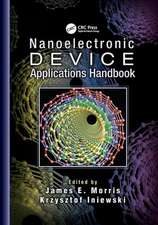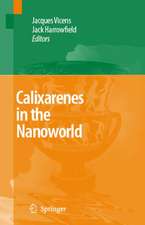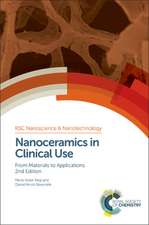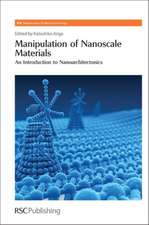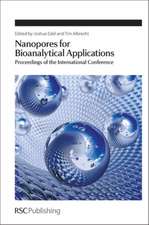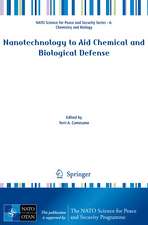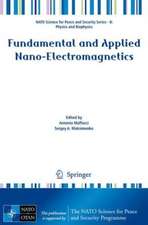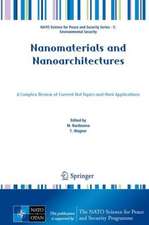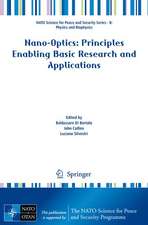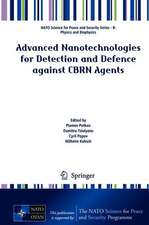Nanoparticles and Occupational Health
Editat de Andrew D. Maynard, David Y.H. Puien Limba Engleză Paperback – 19 oct 2010
The first International Symposium on Nanotechnology and Occupational Health, in 2004, brought together hygienists, manufacturers, toxicologists, materials scientists, regulators and researchers. It pointed the way to what needs to be done. The second International Symposium, 2005, Minneapolis, Minnesota, demonstrated the power and potential where there is a will: with nearly three times as many attendants, and with contributions from academics, industry, policymakers, non-government organizations and even lawyers, this second symposium established that, while there is international concern over how to ensure safe nanotech-workplaces, there is also progress being made in developing the required knowledge.
This volume, a reprint from a special issue of the Journal of Nanoparticle Research, mainly draws from work presented at the 2005 symposium, diverse but united by the need for a holistic view of nanotechnology and risk.
| Toate formatele și edițiile | Preț | Express |
|---|---|---|
| Paperback (1) | 641.38 lei 6-8 săpt. | |
| SPRINGER NETHERLANDS – 19 oct 2010 | 641.38 lei 6-8 săpt. | |
| Hardback (1) | 649.87 lei 6-8 săpt. | |
| SPRINGER NETHERLANDS – 29 ian 2007 | 649.87 lei 6-8 săpt. |
Preț: 641.38 lei
Preț vechi: 754.56 lei
-15% Nou
Puncte Express: 962
Preț estimativ în valută:
122.74€ • 127.67$ • 101.33£
122.74€ • 127.67$ • 101.33£
Carte tipărită la comandă
Livrare economică 14-28 aprilie
Preluare comenzi: 021 569.72.76
Specificații
ISBN-13: 9789048174614
ISBN-10: 9048174619
Pagini: 192
Ilustrații: V, 185 p.
Dimensiuni: 195 x 260 x 10 mm
Greutate: 0.45 kg
Ediția:Softcover reprint of hardcover 1st ed. 2007
Editura: SPRINGER NETHERLANDS
Colecția Springer
Locul publicării:Dordrecht, Netherlands
ISBN-10: 9048174619
Pagini: 192
Ilustrații: V, 185 p.
Dimensiuni: 195 x 260 x 10 mm
Greutate: 0.45 kg
Ediția:Softcover reprint of hardcover 1st ed. 2007
Editura: SPRINGER NETHERLANDS
Colecția Springer
Locul publicării:Dordrecht, Netherlands
Public țintă
ResearchCuprins
Editorial.- Nanotechnology and occupational health: New technologies — new challenges.- Perspectives.- Nanotechnology and society.- Protecting workers and the environment: An environmental NGO’s perspective on nanotechnology.- Special Focus: Nanoparticles and Occupational Health.- Phospholipid lung surfactant and nanoparticle surface toxicity: Lessons from diesel soots and silicate dusts.- Plasma synthesis of semiconductor nanocrystals for nanoelectronics and luminescence applications.- Rationale and principle of an instrument measuring lung deposited nanoparticle surface area.- Calibration and numerical simulation of Nanoparticle Surface Area Monitor (TSI Model 3550 NSAM).- An axial flow cyclone to remove nanoparticles at low pressure conditions.- Measuring particle size-dependent physicochemical structure in airborne single walled carbon nanotube agglomerates.- A comparison of two nano-sized particle air filtration tests in the diameter range of 10 to 400 nanometers.- Modeling of filtration efficiency of nanoparticles in standard filter media.- Experimental study of nanoparticles penetration through commercial filter media.- Reduction of nanoparticle exposure to welding aerosols by modification of the ventilation system in a workplace.- Health risk assessment for nanoparticles: A case for using expert judgment.- Evaluation of nanoparticle emission for TiO2 nanopowder coating materials.- Moving forward responsibly: Oversight for the nanotechnology-biology interface.
Textul de pe ultima copertă
Nanotechnology is rapidly invading many aspects of modern society - from science, research and engineering to industrial and commercial applications and, inevitably, to man and his environment. One of the biggest challenges, therefore, is managing environmental, health and safety risks of nanomaterials. Yet, the information necessary to assess their longterm effects is scarce. Systematic research into what potentially makes engineered nanomaterials hazardous, how this translates into risk, and how these can be managed will be vital and involves interdisciplinary collaboration.
The first International Symposium on Nanotechnology and Occupational Health, in 2004, brought together hygienists, manufacturers, toxicologists, materials scientists, regulators and researchers. It pointed the way to what needs to be done. The second International Symposium, 2005, Minneapolis, Minnesota, demonstrated the power and potential where there is a will: with nearly three times as many attendants, and with contributions from academics, industry, policymakers, non-government organizations and even lawyers, this second symposum established that, while there is international concern over how to ensure safe nanotech-workplaces, there is also progress being made in developing the required knowledge.
This volume, a reprint from a special issue of the Journal of Nanoparticle Research, mainly draws from work presented at the 2005 symposium, diverse but united by the need for a holistic view of nanotechnology and risk.
Audience:
Libraries, laboratories, scientists and researchers, policymakers, international associations and initiatives involved in nanotechnology.
The first International Symposium on Nanotechnology and Occupational Health, in 2004, brought together hygienists, manufacturers, toxicologists, materials scientists, regulators and researchers. It pointed the way to what needs to be done. The second International Symposium, 2005, Minneapolis, Minnesota, demonstrated the power and potential where there is a will: with nearly three times as many attendants, and with contributions from academics, industry, policymakers, non-government organizations and even lawyers, this second symposum established that, while there is international concern over how to ensure safe nanotech-workplaces, there is also progress being made in developing the required knowledge.
This volume, a reprint from a special issue of the Journal of Nanoparticle Research, mainly draws from work presented at the 2005 symposium, diverse but united by the need for a holistic view of nanotechnology and risk.
Audience:
Libraries, laboratories, scientists and researchers, policymakers, international associations and initiatives involved in nanotechnology.
Caracteristici
An overview of recent developments toward assessment and management of hazards and risks associated with engineered nanomaterials An interdisciplinary approach to nanotechnology and occupational health


